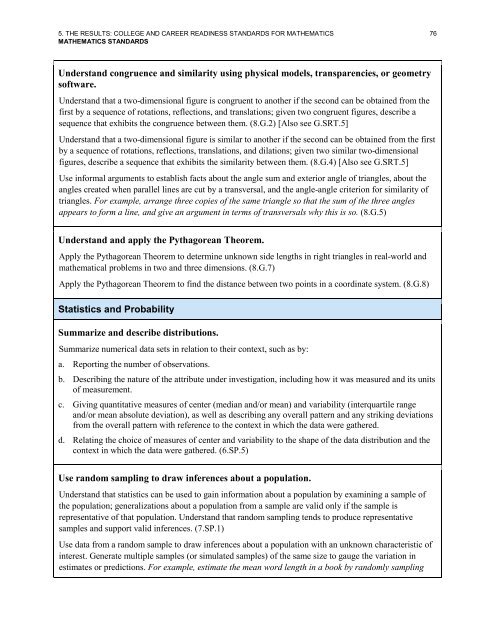CCRStandardsAdultEd
You also want an ePaper? Increase the reach of your titles
YUMPU automatically turns print PDFs into web optimized ePapers that Google loves.
5. THE RESULTS: COLLEGE AND CAREER READINESS STANDARDS FOR MATHEMATICS 76<br />
MATHEMATICS STANDARDS<br />
Understand congruence and similarity using physical models, transparencies, or geometry<br />
software.<br />
Understand that a two-dimensional figure is congruent to another if the second can be obtained from the<br />
first by a sequence of rotations, reflections, and translations; given two congruent figures, describe a<br />
sequence that exhibits the congruence between them. (8.G.2) [Also see G.SRT.5]<br />
Understand that a two-dimensional figure is similar to another if the second can be obtained from the first<br />
by a sequence of rotations, reflections, translations, and dilations; given two similar two-dimensional<br />
figures, describe a sequence that exhibits the similarity between them. (8.G.4) [Also see G.SRT.5]<br />
Use informal arguments to establish facts about the angle sum and exterior angle of triangles, about the<br />
angles created when parallel lines are cut by a transversal, and the angle-angle criterion for similarity of<br />
triangles. For example, arrange three copies of the same triangle so that the sum of the three angles<br />
appears to form a line, and give an argument in terms of transversals why this is so. (8.G.5)<br />
Understand and apply the Pythagorean Theorem.<br />
Apply the Pythagorean Theorem to determine unknown side lengths in right triangles in real-world and<br />
mathematical problems in two and three dimensions. (8.G.7)<br />
Apply the Pythagorean Theorem to find the distance between two points in a coordinate system. (8.G.8)<br />
Statistics and Probability<br />
Summarize and describe distributions.<br />
Summarize numerical data sets in relation to their context, such as by:<br />
a. Reporting the number of observations.<br />
b. Describing the nature of the attribute under investigation, including how it was measured and its units<br />
of measurement.<br />
c. Giving quantitative measures of center (median and/or mean) and variability (interquartile range<br />
and/or mean absolute deviation), as well as describing any overall pattern and any striking deviations<br />
from the overall pattern with reference to the context in which the data were gathered.<br />
d. Relating the choice of measures of center and variability to the shape of the data distribution and the<br />
context in which the data were gathered. (6.SP.5)<br />
Use random sampling to draw inferences about a population.<br />
Understand that statistics can be used to gain information about a population by examining a sample of<br />
the population; generalizations about a population from a sample are valid only if the sample is<br />
representative of that population. Understand that random sampling tends to produce representative<br />
samples and support valid inferences. (7.SP.1)<br />
Use data from a random sample to draw inferences about a population with an unknown characteristic of<br />
interest. Generate multiple samples (or simulated samples) of the same size to gauge the variation in<br />
estimates or predictions. For example, estimate the mean word length in a book by randomly sampling


